Norfolk Island 6m DXpedition
25 March to 07 April 2012

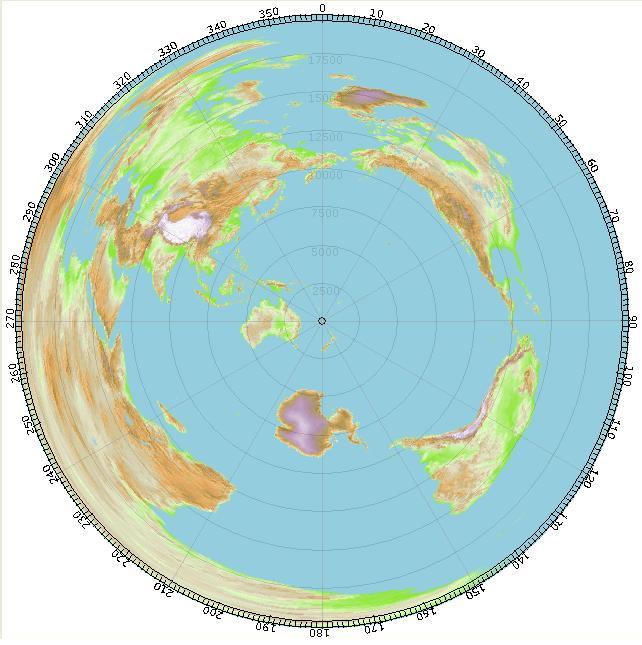
Great Circle Map from Norfolk Island - centered on RG30XX
25 March to 07 April 2012

|
Callsign - VK9N/ZL1RS QTH - "Pacific Palms", Duncombe Bay, Norfolk Island Grid Locator - RG30XX Equipment - IC706mk2g, HB PA, HB 5/5 stacked Yagis at 13.5m and 9m high *** DXpedition closed down on 07 April 2012 at 20:30 UTC *** Final update as at 23:00 UTC on 07 April 2012 6m news via ionospheric propagation: 06 Apr (continued) - Dr Andy worked on his magic Vibroplex bug ... somehow the DXpedition now seems "complete" A very short openings to W6 at 22:00 and 23:00 UTC. Just a few stations worked. K6FV/b was in both times. 07 Apr - The K6FV beacon, although inaudable, was consistently seen on the spectrum display for some hours. Thanks to E51WL the info was passed to the W6's on ON4KST Region 2 chat and we tried some JT65A digital QSOs on 50.193. Actually, the signals soon became so strong that we changed to CW and worked several callers that way before reverting to JT65A to work a couple more stations. K6FV/b faded away soon after and that was the last long haul DX signal heard on 6m via the ionosphere for the DXpedition. 6m news via EME propagation: 07 Apr MR - weak trace seen where VE1JF had been calling on previous days. No decodes. 07 Apr MS - Several callers decoded with good signals, but no QSOs. New stations worked via EME: None New EME callers decoded: UR5MID Previous callers decoded again LZ2WO, S57RR Overall QSO stats: about 1420 QSOs (including 24 via 6m EME and 1 via 70cm EME) with 26 DXCC entities on 5 continents Update as at 20:00 UTC on 06 April 2012 6m news via ionospheric propagation: 06 Apr - Who turned 6m off? 6m news via EME propagation: 06 Apr MR - Very intermittant decodes from VE1JF and W9GA. Called both for half the window each. Nil. 06 Apr MS - Good signals received from several callers. Worked UT7QF and OH2BC. Was sending RRR to S59A for the last 10 minutes of the window but signals faded and no 73 received. QSO confirmed? Note: I will be QRV on 07 Apr MR and MS. The weather is actually so bad today (high winds) that the antennas cannot be taken down safely. Hopefully the wind will have subsided by tomorrow morning. See the updated table near the bottom of this page for the additional EME window times. New stations worked via EME: UT7QF -27, OH2BC -26, S59A -21 (to cfm?) New EME callers decoded: None. Previous callers decoded again VE1JF, W9GA, S57RR Overall QSO stats: about 1400 QSOs (including 24? via 6m EME and 1 via 70cm EME) with 25? DXCC entities on 5 continents Update as at 00:00 UTC on 06 April 2012 6m news via ionospheric propagation: 05 Apr (continued) - TEP from KH6 around 07:00 UTC, again very strong! Just after 20:35 UTC 6m opened to Central America and one station in northern South America. Conditions remained open while shifting north and south for the next hour. Stations worked from TI, XE, HP, and YV. The YS1YS beacon (a.k.a "chirpy") was heard for some time, but no Dr Andy YS1AG? The K6FV/b was in at good strength for a short time, but no W6's heard. Backscatter around the Pacific built up from 22:00 UTC when I worked the E51M North Cooks dxpedition. The XE beacons were still audable at low level until about 23:30 UTC. The Pacifc backscatter gave the opportnity to check the two ZL video carriers at 45.260.36. As suspected they are extremely close in frequency (2Hz difference today) and so impossible to tell apart due to the significant temperature related frequency drift that the Hikurangi carrier definitely has (more than 30Hz drift). 6m news via EME propagation: 05 Apr MR - Worked N5DG and called VE1JF for the rest of the window. Big QSB on both stations. 05 Apr MS - several good signals received here, but then about half way into the window they all faded and nothing was decoded for the rest of the window. The local indicators were checked after the EME window and many were coming in via Es from both the east and the west. They were not present before the moon set window indicating some ionospheric activity started that upset the EME signals. Note: I may be QRV on 07 Apr MR and MS depending on the weather. If the forecast is good I will delay dismantalling the antenna system until 20:30 UTC on 07 Apr. See the updated EME window table near the bottom of this page for the additional times. I will try to leave a confirmation on ON4KST EME chat. New stations worked via EME: N5DG -24 New EME callers decoded: S57RR Previous callers decoded again VE1JF, UT7QF, S59A, PE1L Overall QSO stats: about 1390 QSOs (including 21 via 6m EME and 1 via 70cm EME) with 22 DXCC entities on 5 continents Update as at 04:00 UTC on 05 April 2012 6m news via ionospheric propagation: 02 Apr - weak caller from W6 on 50.110.8 (rxed "de K6..." and "...ZL1RS?") at around 23:00 UTC (no QSO) Very weak evening TEP to JA. 03 Apr - brief/weak opening to JA at 03:00 UTC, BY at 06:00, KH6 very strong at 07:00, and JA again weakly from 08:20 until 09:00 UTC 04 Apr - almost exactly the same TEP openings as occurred yesterday but signals a little stronger and the propagation lasting a little longer. Strong 49.75 vids with "in-band" spurs. Several JA beacons heard but few callers (busy at work I guess?) A video carrier on 48.260.42 was detected weakly at 07:45 UTC for about 20 minutes with another weaker one about 150Hz lower (I didn't note it's exact frequency). No other 48 MHz vids have been detected while here. Likewise, no South American beacons or indicators. K7JA answered my keyer at 22:26 UTC and then followed a few other W6 stations. The propagation to the western USA really picked up from 23:10 UTC for about 45 minutes and a nice stream of W6 and W7 went into the log on both CW and SSB. During this time the K6FV beacon was quite strong (up to S7 on the meter). 05 Apr - Another brief wave of propagation from W6 around 01:30 UTC. Again K6FV bcn was good copy but there were not many callers. A few stations that were worked earlier chipped in with quick signal reports to let me know that my signal was still coming through. Most of the opening was spent listening to a couple of W6's having a "good old chin wag" for some 15-20 minutes on 50.110 At around 02:00 UTC there was strong backscatter out of the NE and KH7Y was heard calling CQ. While tuning about for beacons and indicators I saw a weak trace on 50.0772 and caught a few letters leading me to believe it was OA4TT/b. The signal trace only peaked from the NE, so if it was OA4TT/b it would have been coming via backscatter from the same path as KH7Y. What a shame Jack was not at his Peru radio QTH! 6m news via EME propagation: 03 Apr MR - signals floating in and out. Best peak just above moon rise and again at about 6 degrees Called two stations (JF, DG) for about 1/2 the window each, no reply. Very weak and occasional own echos 03 Apr MS - "one way" propagation. Big and consistant signals received here (especially from G8VR -19) but no QSOs. HB9Q worked on 70cm via EME just before the 6m moonset window. 04 Apr MR - Signals decoded from two callers (GA, JF), replied 30 mins each. No QSOs, no own echos. 04 Apr MS - Seven callers decoded and a few more undecoded traces. At times signals were so good that the SpecJT screen was "lit up like a Christmas Tree"! Two stations worked. New stations worked via EME: HB9Q -27 (70cm), G8VR -21, PC5C -21 New EME callers decoded: VE1JF, N5DG, G8VR, OZ4VV, W9GA, OZ1DJJ Previous callers decoded again LZ2WO, UT7QF, S59A, OZ4VV Overall QSO stats: about 1300 QSOs (including 20 via 6m EME and 1 via 70cm EME) with 18 DXCC entities on 4 continents The 70cm EME Antenna 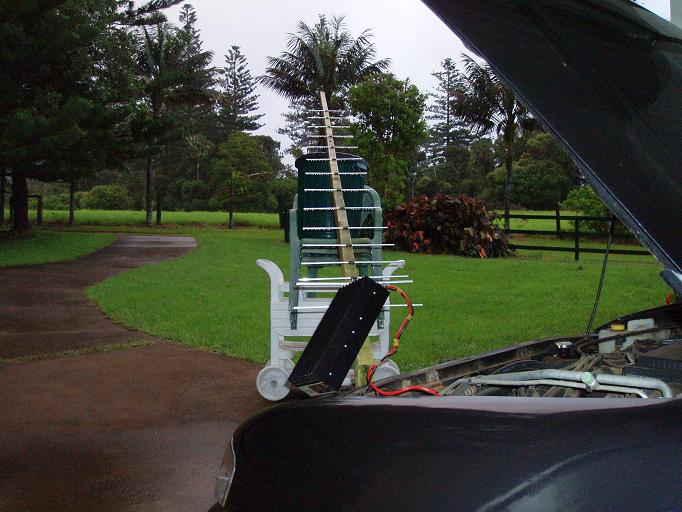
Fifteen element 70cm Yagi. Elements fixed to a wooden fence railing with electrical "p-clips". The wooden boom was propped up on some garden furniture and a rubbish tin to elevate 15 degrees for the moon! A Mirage D1010 "brick" amplifier is right at the Yagi feedpoint and connected to the rental car battery. Update as at 21:00 UTC on 02 April 2012 6m news via ionospheric propagation: 02 Apr - strong backscatter to the NE for several hours from 00:00 but no DX weak openings to JA at 04:30 and 07:30 UTC, and brief Es to VK4 at 07:00 UTC 6m news via EME propagation: 02 Apr MR - backscatter from NE strongly inhibited signals, but still managed one QSO. No own echos 02 Apr MS - big swings in signals, different QSB on the various EU signals decoded. No QSOs, no own echos New stations worked via EME: K7XQ -27 New EME callers decoded: none (but 3 previous callers decoded, S59A, G4FUF and LZ2WO) Overall QSO stats: about 1230 QSOs (including 18 via EME) with 16 DXCC entities on 4 continents Update as at 00:00 UTC on 02 April 2012 6m news via ionospheric propagation: 30 Mar - Another great afternoon TEP opening to Asia with some good signals (30dB over S9) Also a weaker evening TEP opening to JA, and a weak opening to W6/W7 around 23:30 to 01:00 UTC 31 Mar - A moderate afternoon TEP opening to Asia from 03:00 UTC until the best TEP so far on this trip. Big signals from Japan and Korea in the evening from 05:30 until 08:30 UTC ... and I mean BIG signals!! Many stations were S9+ with the IC706 attenuator on! Worked a nice pile-up with the gentlemen from JA. My brain will not cope with CW under these exceptional conditions (when there are dozens of callers all at 60db over 9), so forgive me if I only operate on SSB when the band is "wide open" again. 01 Apr - Just a short period of backscatter and poor MS pings from the local 6m stations during my local day time. A short and weak opening to KH6 from 02:15 until 02:30 UTC, and then again to KH6 much stronger via evening TEP at 07:00 utc. Another weak to moderate opening to JA from 04:00 until 06:00 UTC. Still no 48 MHz vids in the evening (or the morning) from SEA, ME, AF or EU. Also, no indicators or beacons from Central or South America yet despite looking hard for them. 6m news via EME propagation: 30 Mar MS - difficult conditions with deep QSB and infrequent own echos (49 MHz vids were in) One station worked. 31 Mar MR - consistent own echos, but no callers seen 31 Mar MS - slightly better conditions, but periods of several minutes with no signals. No own echos. Two stations worked. Several regular callers decoded. 01 Apr MR - fairly steady signals with some complete fades for one or two sequences. Was sending RRR to VE5UF when the moon was high and lost the moon without seeing 73 (QSO confirmed). Another caller at around DF = -300 sending OOO (# indicated), but callsigns not decoded. GL next time! Two stations wkd. 01 Apr MS - good steady peak to start, then deep QSB later in the window. One station worked. New stations worked via EME: G3WOS -19 IW5DHN -18 OK1RD -22 N3CXV -25 VE5UF -24 G5WQ -21 New EME callers decoded: PE1L, UT7QF and a few other traces ... Overall QSO stats: about 1210 QSOs (including 17 via EME) with 16 DXCC entities on 4 continents General location picture - Duncombe Bay, Norfolk Island 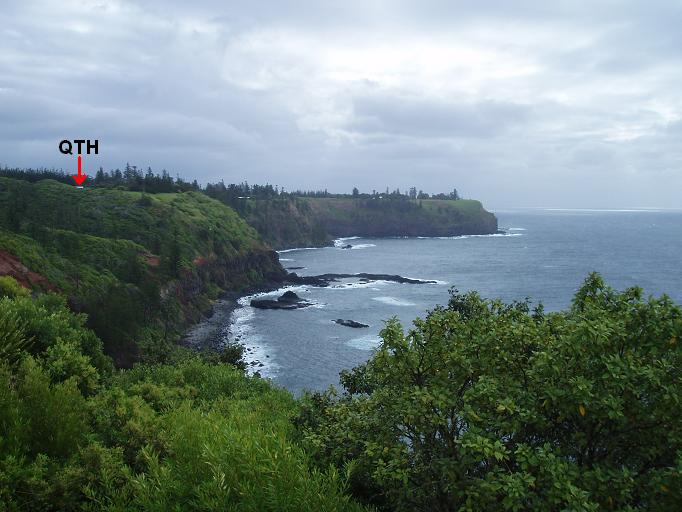
Picture taken looking due West from the Captain Cook Memorial lookout. Update as at 00:00 UTC on 30 March 2012 6m news via ionospheric propagation: I'm making a short CQ on 50.110.6 once every 3 minutes or so with the auto-keyer when 6m is likely to be open. When there is an opening with good propagation I have been QSYing to 50.104 or 50.105 for CW and SSB QSOs. A nice opening on 28/29 Mar to VE7 and the NW USA with over 70 stations worked. Nothing further south except one or two W6 stations. TI7/N5BEK also heard. The KH6 beacons were S9 at around 07:30 utc last night, and Fred KH7Y was very loud. A few JAs and one DU worked from the NW direction yesterday. The 49.750 vids were weak. A few stations from NA have looked for my JT65A CQs on 50.190 at moon rise and so we have managed "direct" digital QSOs with N6KK and K7CW when 6m apprears "closed". Obviously the band is marginally open and the sensitivity of JT65A makes the difference. My moon rise direction is still close towards the NA azimuth for the next few days. See the table towards the bottom of this page for my moon rise times. If you decode or hear my digital signal, please call. I am not propagation mode or signal mode specific and am more than happy to work anyone, anywhere, anytime on any mode via any means! :-) 6m news via EME propagation: The ground gain lobe and nulls are now very well defined and it is pointless operating with the moon any higher than 10 degrees here where the first null starts. Due to the antenna system being stacked 5/5 Yagis there are no higher lobes. To this end, I will finish earlier on moon rise windows and start later on moon set windows (therefore the window times given below will be 10 or so minutes shorter in each case). EME conditions the last 2 windows have been VERY difficult ... rapid QSB, etc ... but the best EME conditions by far are still to come early next week! Good luck to all. New stations worked via EME: G4IGO -25 New EME callers decoded: LZ2WO OK7XX W7MEM (both via moon echo and via ionosphere simultaineously) G5WQ and a few other traces ... Pictures of the antenna system during assembly and when first raised 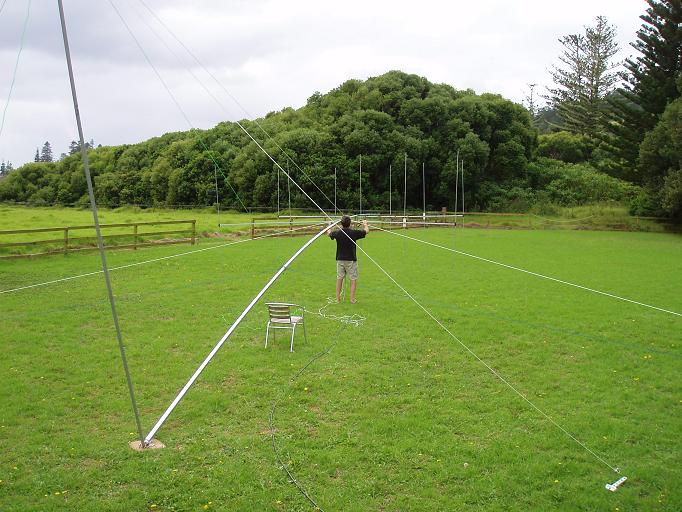
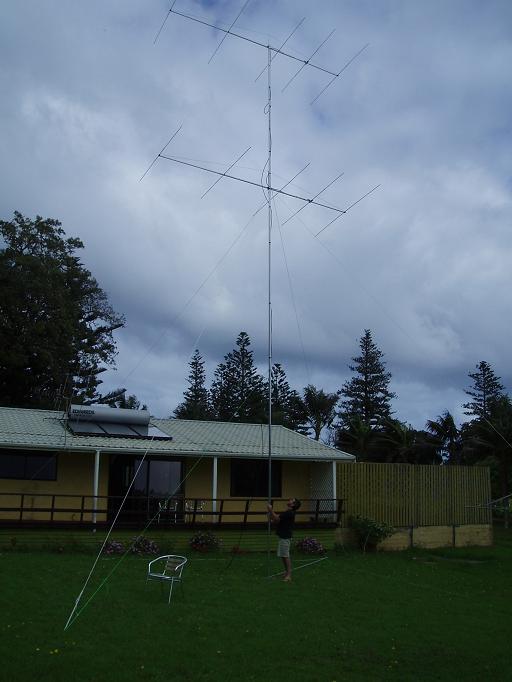

5 over 5 homebrew design and build, 25 ohm feedpoints, 3/4wl LMR-400 phasing lines/impedance transformers 
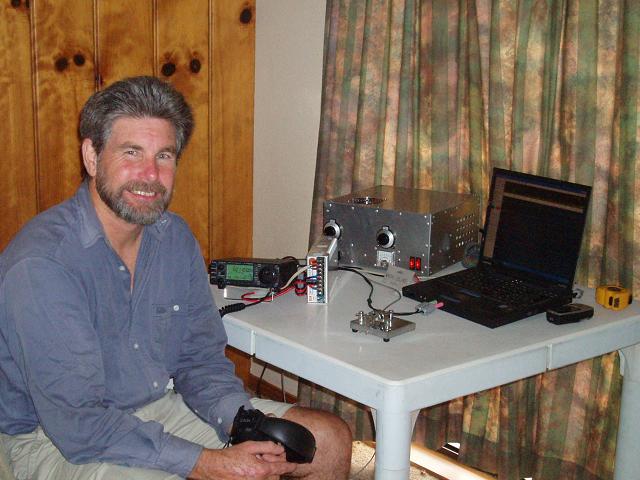
Some crazy guy ... I dunno ???? Update as at 00:00 UTC on 28 March 2012 VK9N/ZL1RS - a.k.a the trip of disasters ... (I won't bore you with the list!) However, all the equipment and antennas are now assembled and fully operational The Yagi stack and 13.5m portable mast system assembled and raised "like a dream" SWR below 1.2:1 from 49.8 to 50.6 without adjustment It is an absolute pleasure to operate from a site with NO noise and NO "birdies"! 6m news via ionospheric propagation: Over 200 6m stations worked on the first day, most during a long TEP opening to JA Stations have been heard from Central America, Asia and the Pacific Lots of two-way radio and data signals are heard daily between 30 and 40 MHz low level 49.750 MHz TV video carriers each late afternoon/evening no 48 MHz TV video carriers heard yet some VK4's heard via MS enhanced forward scatter (1500km), but no full QSOs 6m news via EME propagation: Experience from the first few "moon windows"... Moonrise over the ocean, signals decoded from -1 degree Best peak around 2 degrees, secondary peak around 6 degrees Moonset across 100m of flat paddocks, peak from +8 down to +3 degrees The WORST place to call is "on frequency" e.g. QRM from Eu on second moon set there were 4 stations within 50Hz of zero DF ... difficult! I can easily see from -800Hz to +700Hz off center frequency, so S-P-R-E-A-D O-U-T THE GOLDEN RULE ... please ONLY send calls+OOO if you have one of the following: - a GOOD/DEFINITE TRACE during the PREVIOUS sequence - a FULL DECODE during the PREVIOUS sequence Note carefully ... "during the PREVIOUS sequence" ! It is very easy to select Tx1 or Tx2 accordingly for EACH of your TX sequences (I seem to "decode" far better than I "transmit", so ...) Worked via EME: G8BCG -20 W1JJ -14 W7GJ -12 ZL3NW -19 K2ZD -23 N7NW -22 ON4GG -19 ES6RQ -23 ON4IQ -21 K6MYC -18 Other EME callers decoded: IW5DHN K7CW G4FUF S59A G3WOS OK1RD and a few other traces ... A fair result so far considering it is apogee and the overall degr. is bad Potential VK9N/ZL1RS EME MR/MS operating times (UTC): Note: due to the narrow ground gain lobe from the stacked antenna system, the window times are shorter Moon Rise (MR) windows finish 10 minutes earlier than these times Moon Set (MS) windows start 10 minutes later than these times 25.03 26.03 26.03 27.03 27.03 28.03 29.03 29.03 30.03 30.03 31.03 31.03 01.04 01.04 02.04 02.04 03.04 03.04 04.04 04.04 05.04 05.04 06.04 06.04 Extra windows, but subject to the weather being OK for "last minute" antenna dismantling and pack up... I will try to update this page and leave a comment on ON4KST EME Chat with a confirmation (or not). 07.04 07.04 07.04 For EME, VK9N/ZL1RS will always TX First on 50.190 JT65A Peak ground gain lobe is expected between 3-9 degrees of moon elevation at VK9N Please use "callsigns + OOO" format ONLY if "seeing" VK9N/ZL1RS during the PREVIOUS period Check ON4KST EME page for updates (infrequent due to no Internet access at the accomodation) 73, Bob VK9N/ZL1RS |

Great Circle Map from Norfolk Island - centered on RG30XX